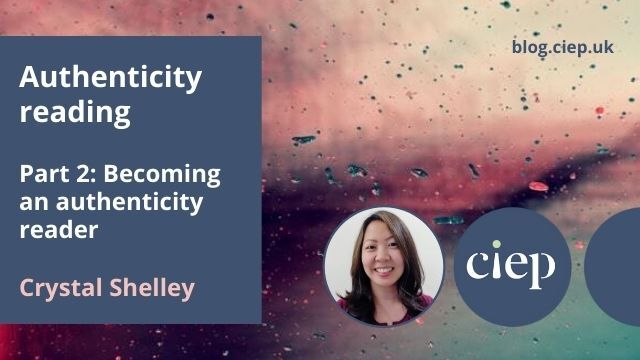In Part 1 of this two-part series, Crystal Shelley explained what authenticity reading is and isn’t, why it’s important and how editors can help their clients by recommending it when relevant. In Part 2, she shares how professional editors can add authenticity reading to their services.
Here’s what will be discussed in this post:
- Decisions to sort out first
- The process of doing the job
- Where to find clients
 Offering authenticity reading as a service
Offering authenticity reading as a service
If you’re passionate about assessing writing related to your identities or lived experiences, you may consider adding authenticity reading to your services. After all, many professional editors are in a prime position to do this because working with clients, assessing writing and crafting feedback are all muscles that are flexed daily. Let’s take a look at some of the key aspects to consider when deciding to become an authenticity reader.
Preliminary decisions
Before you dive right into calling yourself an authenticity reader, there are some considerations to work through first.
Topics
One of the first decisions you have to make is what topics you’ll read for. What social identities do you hold that writers might hire you to assess? What unique experiences have you had? Think about the representation you’ve read that’s made you angry because it was inaccurate or harmful based on what you know or have experienced. That might be a topic you can read for.
Training
There’s no formal training that qualifies you to become an authenticity reader. That said, resources exist to provide information on what you need to know to offer this service, such as a recorded webinar and booklet from the Editorial Freelancers Association. Before I started offering authenticity reading, I also scoured the internet for articles and discussions about it, especially from the perspectives of authenticity readers.
Pricing
As with editing, there are no set prices for authenticity reading, so you’ll have to decide what to charge. I’ve seen fees ranging from £0.004 to £0.015 per word. You won’t be making direct interventions to the text but will instead be leaving feedback, so your working pace will likely be faster than it is while editing. At the same time, consider what you’re being asked to do. There is often emotional labour involved in authenticity reading, and you may be reading text that is harmful or even traumatising.
Your limits
Know what you are and are not willing to read. Many of the topics that authenticity readers assess are related to personal identity or lived experience, and there’s a chance that the writing might include representations of hate, bias, microaggressions or past traumas. If there are certain topics you won’t read, screen potential clients for this type of content before you agree to a project. There’s nothing wrong with setting boundaries and taking care of yourself, especially when you’re often being asked to approach writing from a place of vulnerability.
Doing the job
Once you’ve worked through the preliminary decisions, you have to be prepared to do the job. Your task is to use your lived experience or expert knowledge to provide feedback to the client, but what does that actually look like? Every authenticity reader has their own process, but these are the steps I go through for each project:
Set expectations from the get-go
In Part 1 of this series on authenticity reading, I outlined several common misconceptions about authenticity reading. In the proposals I send to potential clients, I dispel these myths right away because I want the client to know what they can and should not expect from authenticity reading.
Clarify what the client wants you to focus on
Some clients will simply say that they want a general read, whereas others have specifics they’re concerned about. I always check if there are certain areas the client wants me to pay attention to, such as terminology, whether an experience is accurate, or if a character is stereotyped.
Read the manuscript
I read the entire manuscript once, and I make notes of what works well and what should be reconsidered.
 Leave comments in the manuscript
Leave comments in the manuscript
As I’m reading, I also leave comments in the manuscript, as I would in an edit. I want the client to know my impressions, and I leave feedback on specific elements of the writing. I’ll write a comment if a word gets misused, if a character’s description is problematic, or if I have a positive or negative reaction to something specific.
Write a report summarising feedback
I turn the notes I took while reading through the manuscript into a report. Because I mainly work on fiction, my report is usually broken down into sections on plot, characterisation, dialogue and behaviours, cultural elements and settings, and conscious language. If I have resources to share that will reinforce my feedback, I’ll include those as well.
Answer the client’s questions and concerns
Once I deliver the marked manuscript and report, I’ll answer whatever questions or concerns the client has about my feedback. This is usually done through email, but I also do phone or video calls if requested.
Finding clients
Once you’re ready to do the job, it’s time to find clients. There are many avenues through which to reach potential clients, and these are a few ideas to try:
Business website
Add authenticity reading to your website as an offered service. Be sure to list which topic(s) you read for.
Social media
Talk about authenticity reading on social media so that your followers know that you’re offering the service. I’ve also seen tweets when indie authors or publishers are looking for readers – you never know what’ll pop up. You can also join the Binders Full of Sensitivity Readers group on Facebook. (Please note that this group is for readers of marginalised genders only.)
Directories and databases
If you’re an editor of colour, join the Editors of Color database and sign up for the job list. Add authenticity reading (or sensitivity reading) to your CIEP Directory entry so you’ll pop up when prospective clients do a keyword search.
Publishers
Many book publishers and presses hire authenticity readers and maintain databases of freelancers. Consider contacting publishers to let them know you offer this service and what topics you read for.
Final thoughts
Authenticity reading is an important and rewarding part of publishing that you may want to consider dipping your toe into. Even if editors don’t formally offer it as a separate service, we can still leave feedback for writers based on our identities and lived experiences – to help writers avoid doing unintentional harm, and to help readers see more authentic representations of themselves and their experiences in writing.
Are you interested in becoming an authenticity reader? Let us know in the comments!
About Crystal Shelley
Crystal Shelley is a licensed clinical social worker and the owner of Rabbit with a Red Pen, where she provides editing and authenticity reading services to fiction authors. She is the creator of the Conscious Language Toolkit for Editors and serves on the Executive Committee of ACES: The Society for Editing.
 About the CIEP
About the CIEP
The Chartered Institute of Editing and Proofreading (CIEP) is a non-profit body promoting excellence in English language editing. We set and demonstrate editorial standards, and we are a community, training hub and support network for editorial professionals – the people who work to make text accurate, clear and fit for purpose.
Find out more about:
Photo credits: Hours of happiness by Jr Korpa; Read by Ishaq Robin, both on Unsplash.
Posted by Abi Saffrey, CIEP blog coordinator.
The views expressed here do not necessarily reflect those of the CIEP.


